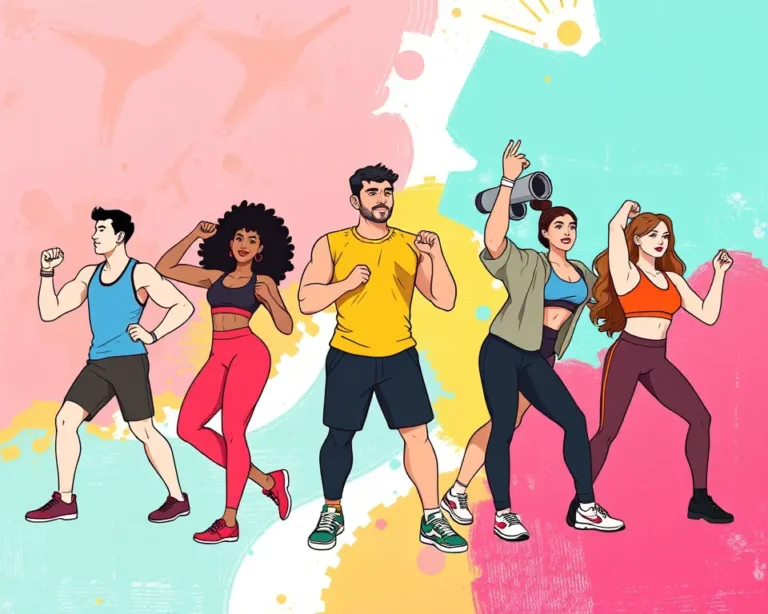High-Intensity Interval Training (HIIT) is a popular and effective workout method, but its high-impact nature can be tough on the joints. Low Impact HIIT offers a solution, providing the benefits of HIIT without the jarring movements. This guide will provide a 30-day plan to help you achieve your fitness goals.
What is Low Impact HIIT?
Low Impact HIIT involves performing high-intensity exercises with modifications that reduce stress on your joints. Unlike traditional HIIT, which often includes jumping jacks, burpees, and other high-impact moves, Low Impact HIIT focuses on exercises that keep at least one foot on the ground at all times or utilize seated positions. This makes it a great option for:
- Beginners
- Individuals with joint pain or arthritis
- People recovering from injuries
- Seniors
- Overweight individuals
Benefits of Low Impact HIIT
Low Impact HIIT offers a multitude of benefits, including:
- Improved Cardiovascular Health: It challenges your heart and lungs, strengthening your cardiovascular system.
- Increased Calorie Burning: The high-intensity intervals burn calories during and after your workout, boosting your metabolism.
- Joint-Friendly: Minimizes stress on your joints, making it suitable for people with joint issues.
- Enhanced Metabolic Health: Improves your body’s efficiency in delivering oxygen to muscles.
- Psychological Benefits: Reduces stress, improves overall well-being, and promotes a healthier lifestyle.
- Time-Efficient: Delivers significant results in shorter workout sessions.
- Accessibility: Suitable for various fitness levels and ages.
- Long-Term Sustainability: Easier on the body, allowing for consistent activity without excessive stress.
Low Impact HIIT vs. Traditional HIIT
| Feature | Low Impact HIIT | Traditional HIIT |
| —————- | ——————————————— | ——————————————— |
| Impact | Low; at least one foot on the ground | High; involves jumping and high-impact moves |
| Joint Stress | Minimal | Higher risk of joint stress |
| Intensity | High | High |
| Exercise Examples | Squats, lunges, push-ups (modified), cycling | Burpees, jumping jacks, squat jumps |
| Suitability | Beginners, joint issues, injury recovery | Those without joint issues and with experience |
Getting Started with Your 30-Day Transformation
Setting Goals
Before starting your 30-day Low Impact HIIT journey, it’s important to set realistic and achievable goals. Consider what you want to achieve, whether it’s weight loss, improved endurance, or increased strength.
- Be Specific: Instead of “get in shape,” aim for “lose 5 pounds” or “increase plank time by 30 seconds.”
- Be Measurable: Track your progress to stay motivated.
- Be Attainable: Ensure your goals are realistic for your current fitness level.
- Be Relevant: Make sure your goals align with your overall health and wellness objectives.
- Be Time-Bound: Setting a deadline (30 days) creates urgency and focus.
Essential Equipment
The best part about Low Impact HIIT is that it requires minimal equipment. You can do most exercises with just your body weight. However, consider the following:
- Yoga Mat: Provides cushioning and grip.
- Comfortable Workout Clothes: Allows for free movement and breathability.
- Supportive Shoes: Important for protecting your feet and joints.
- Water Bottle: Stay hydrated throughout your workouts.
- Optional: Dumbbells or resistance bands can be added for extra intensity.
Understanding HIIT Principles
HIIT involves alternating between short bursts of intense exercise and brief recovery periods. The typical structure includes:
- Warm-up: 5-10 minutes of light cardio and dynamic stretching to prepare your body.
- Work Interval: 20-40 seconds of high-intensity exercise.
- Rest Interval: 10-20 seconds of low-intensity activity or complete rest.
- Cool-down: 5-10 minutes of static stretching to reduce muscle soreness.
Adjust the work-to-rest ratio based on your fitness level. Beginners can start with longer rest periods and gradually decrease them as endurance improves.
Sample 30-Day Low Impact HIIT Plan
This plan is a guideline and can be adjusted based on your fitness level and preferences. Remember to listen to your body and take rest days when needed.
Week 1: Foundation
- Focus: Building a base level of fitness and learning proper form.
- Workout Frequency: 3 days per week, with rest days in between.
- Workout Structure:
- Warm-up: 5 minutes of marching in place, arm circles, and leg swings.
- HIIT: 20 seconds of work, 40 seconds of rest, 8 rounds.
- Cool-down: 5 minutes of static stretches.
- Exercises:
- Squats
- Push-ups (on knees or against a wall)
- Lunges (alternating legs)
- Plank (hold for 20 seconds)
Week 2: Increasing Intensity
- Focus: Gradually increasing the intensity and duration of the workouts.
- Workout Frequency: 4 days per week.
- Workout Structure:
- Warm-up: 5 minutes of dynamic stretching.
- HIIT: 30 seconds of work, 30 seconds of rest, 10 rounds.
- Cool-down: 5 minutes of static stretches.
- Exercises:
- Squat with Overhead Press (using light dumbbells)
- Incline Push-ups
- Reverse Lunges
- Glute Bridges
Week 3: Adding Variety
- Focus: Introducing new exercises to challenge different muscle groups.
- Workout Frequency: 4 days per week.
- Workout Structure:
- Warm-up: 5 minutes of dynamic stretching.
- HIIT: 35 seconds of work, 25 seconds of rest, 12 rounds.
- Cool-down: 5 minutes of static stretches.
- Exercises:
- Wall Sit
- Bird Dog
- Calf Raises
- Bicycle Crunches (Low Impact)
Week 4: Maximizing Results
- Focus: Pushing your limits and consolidating your progress.
- Workout Frequency: 5 days per week.
- Workout Structure:
- Warm-up: 5 minutes of dynamic stretching.
- HIIT: 40 seconds of work, 20 seconds of rest, 14 rounds.
- Cool-down: 5 minutes of static stretches.
- Exercises:
- Sumo Squats
- Renegade Rows (with dumbbells)
- Standing Oblique Crunches
- Supermans
Sample Low Impact HIIT Exercises
- Squats: Stand with feet shoulder-width apart, lower your hips as if sitting in a chair, and keep your back straight.
- Lunges: Step forward with one leg and lower your body until both knees are bent at 90 degrees. Alternate legs.
- Push-ups (Modified): Perform push-ups with your knees on the ground or against a wall to reduce the intensity.
- Glute Bridges: Lie on your back with knees bent and feet flat on the floor. Lift your hips off the ground, squeezing your glutes at the top.
- Plank: Hold a straight line from head to heels, engaging your core muscles.
- Wall Sit: Lean against a wall with your knees bent at 90 degrees, holding the position.
- Bird Dog: Start on your hands and knees, then extend one arm forward and the opposite leg backward simultaneously.
- Calf Raises: Stand with your feet flat and lift up onto your toes.
- Bicycle Crunches (Low Impact): Lie on your back and bring your knee towards your chest while twisting to meet it with the opposite elbow, alternating sides.
- Sumo Squats: Stand with feet wider than shoulder-width apart, toes pointed outwards, and lower your hips.
- Renegade Rows: Start in a plank position holding dumbbells, and alternate lifting each dumbbell towards your chest.
- Standing Oblique Crunches: Stand with feet shoulder-width apart, place your hands behind your head, and lean to one side, engaging your obliques.
- Supermans: Lie on your stomach and lift your arms and legs off the ground simultaneously.
- Marching in Place: Lift each knee towards your chest alternatively.
- Arm Circles: Extend arms to the sides and make small or large circles.
- Leg Swings: Swing one leg forward and backward, keeping it straight.
- Squat with Overhead Press: Perform a squat and as you stand up, press dumbbells overhead.
- Incline Push-ups: Perform push-ups with your hands elevated on a bench or step.
- Reverse Lunges: Step backward with one leg and lower your body until both knees are bent at 90 degrees.
- Side Plank: Lie on your side and lift your body off the ground, supporting yourself on your elbow.
- Front Kicks: Kick one leg straight in front of you, alternating legs.
- Side Lunges: Step to the side with one leg and lower your body, keeping the other leg straight.
- Knee Driver: Drive one knee towards your chest, alternating legs.
- Lying Leg Raises: Lie on your back and lift your legs straight up towards the ceiling.
- Elliptical: Mimics the motion of running, but without the high impact.
- Stationary Bike: Offers a cardiovascular workout with adjustable resistance.
- Rowing Machine: Provides a full-body workout with low impact.
Maximizing Your Results
- Stay Consistent: Stick to your workout schedule as much as possible.
- Proper Form: Focus on maintaining correct form to prevent injuries.
- Listen to Your Body: Take rest days when needed and don’t push through pain.
- Stay Hydrated: Drink plenty of water throughout the day.
- Nutrition: Combine your workouts with a healthy diet for optimal results.
- Track Progress: Monitor your weight, measurements, and exercise performance.
- Get Enough Sleep: Aim for 7-8 hours of sleep per night to support recovery.
- Warm-up and Cool-down: Never skip these essential parts of your workout.
- Progression: Gradually increase the intensity, duration, or complexity of your workouts as you get stronger.
Nutrition Tips for a 30-Day Transformation
Nutrition plays a vital role in achieving your fitness goals. Here are some guidelines:
- Balanced Diet: Focus on whole foods, including fruits, vegetables, lean proteins, and whole grains.
- Protein Intake: Consume enough protein to support muscle repair and growth.
- Limit Processed Foods: Reduce your intake of sugary drinks, processed snacks, and fast food.
- Hydration: Drink plenty of water throughout the day.
- Meal Timing: Eat a balanced meal before your workout and a protein-rich snack after your workout.
Staying Motivated
- Find a Workout Buddy: Exercising with a friend can provide support and accountability.
- Create a Playlist: Listen to upbeat music to stay energized during your workouts.
- Reward Yourself: Celebrate your achievements with non-food rewards.
- Visualize Success: Imagine yourself achieving your goals to stay motivated.
- Track Your Progress: Seeing your improvements can boost your motivation.
Conclusion
Low Impact HIIT is a powerful and accessible workout method for transforming your body in 30 days. By following this guide, setting realistic goals, and staying consistent, you can improve your cardiovascular health, burn calories, and build strength without stressing your joints. Remember to listen to your body, stay hydrated, and combine your workouts with a healthy diet for optimal results.







